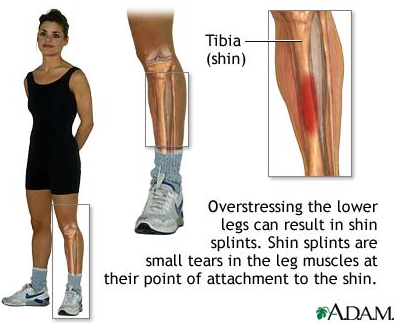By Sandra Hume
If you were asked to make a list of the muscles that were most important to take care of, your shins might not even make the top five, especially if they’ve never given you trouble. 
But anyone who’s experienced shin pain knows all too well the importance of the bones between the knee and the ankle — the fibula and tibia — and specifically the muscles that attach to them.
In everyday life, shins play a pretty crucial role, says Robert Steigerwald, M.A., exercise physiologist and personal trainer in Huntington, NY. (Find him on Twitter as @metabolicbob.) The muscles surrounded by the tibia and fibula bones of the shin help with basic balance and make walking over anything uneven possible. Thank your shins when you can navigate up the stairs, down a hill and onto a sidewalk.
Once we incorporate exercise into life — even something as simple as walking — we ask more of these muscles. Shins can easily be overexerted and result in shin pain, which is commonly known as “shin splints.”
What are shin splints?
Overused shin muscles will swell, but because the bones and surrounding tissue (a sheath known as fascia) provide little room for swelling, the added pressure reduces blood flow and causes tenderness — both of which can result in pain, or shin splints. Shin splints are more likely to occur in people who have begun a new exercise routine (like taking up running as an adult) or who do a lot of stop-and-start movement (military training, some aerobic workouts).
How to treat and prevent shin injuries
Go slowly. If you’re just starting (or re-starting) to exercise and your shins hurt, take it easy. “Start off slow and your body will adapt as you go on,” says Steigerwald. Moving too quickly will intensify the problem.
Pay attention to footwear. Flat feet are often cited as a cause of shin splints, in which case special footwear can help address the problem.
Even if you don’t have flat feet, getting properly fitted for footwear designed for the exercise you’ll be doing will help protect your feet, and by extension your shins.
Also, replace shoes as they become worn out. Barbara Boustead, a runner in Omaha, Neb., knows that when she starts feeling pain in her shins, it’s time to shop for new running shoes.
- Stretch. Careful stretching after a quick warm-up and before and after your main exercise can help. More conditioned athletes might need to simply increase their stretching and warm-up time. There are many stretches that will help your shins; here are two.
- Stretch 1: Seated and with one leg extended, flex and point the toes. Hold for 15-20 seconds. After three or four repetitions of 12, do the same with the second leg. Repeat as needed.
- Stretch 2: Stand on a step with your heel hanging over the edge. With knees slightly bent, drop your heel below the step, then lift back up high on your toes. Repeat, then switch legs and do the same.
- Rest and ice. Ice and anti-inflammatory medication can address pain and swelling. In some cases, your muscles simply need a rest — either from exercise completely or by switching to a lower-impact form of exercise, like swimming or cycling.
No matter what your activity level, chronic pain can indicate tendinitis or even a bone fracture and should be addressed by a doctor.
